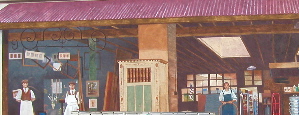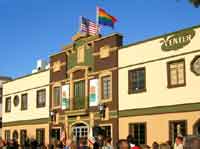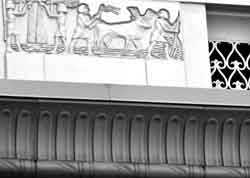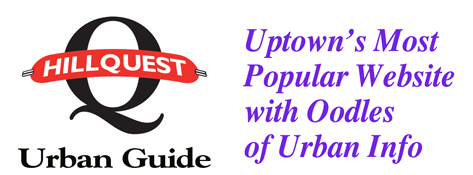Here you go! An enjoyable stroll that takes you through the eastern side of Hillcrest through a beautiful urban canyon, the northern end of Balboa Park and back to Hillcrest. Start or stop anywhere along the way on this several hour loop tour through history.

1. Ace Hardware Mural. Tenth Avenue south of University. Painted in 1999 by Linda Churchill.
2. Hillcrest Streetscape Project. Check out the new sidewalk improvements over the next few blocks. The first phase, the landscaped median along University from Tenth east to Normal, was completed over a decade ago. In 2006 two blocks of new sidewalks, street lamps and pop-outs on the south side of University Avenue between Vermont and Herbert were finished. This was phase two of a $1.6-million master plan. The final phase (the Normal Street median project) is scheduled for completion within the next few years.
John Wear Memorial. Locate this bronze plaque near the curb in front of Obelisk Bookstore. In 1991 this teen was chased down and killed because his assailants thought he was gay. The community is dedicated to ending hatred and violence on our streets.
Rich’s. 1051 University Avenue. Originally built as a furniture warehouse, this site has been home to a progression of nightclubs since the 1950s. Mickie Finn’s speakeasy featured the popular beauty singing and playing the banjo. In 1966 the sing-along show was nationally broadcast on TV from a set replicating the cozy pub interior. Rich’s, a popular gay club located here since 1991, features dancing and theme nights ranging from Studio 54 to Club Hedonism. A streetcar stop was located here till the line shut down in 1949. The Original French Laundry, a commercial building designed by Frank P. Allen was located across the street from here.
4. Uptown District. The neighborhood’s first experiment with mixed-use development, the Uptown District houses 318 residential units and a variety of retail stores. In September 1986, the City of San Diego purchased the 14-acre abandoned Sears store and surrounding parking lot for $9 million. Though the site was originally intended to house the city’s new central library, the City Council — with input from citizens groups including Uptown Community Planners and the Hillcrest Business Association — decided to revitalize the area with additional housing and retail.
Construction of the $70 million project was completed in 1990 and has attracted national attention as a model for redeveloping low density, obsolete commercial sites for new housing and community uses. The project served as the cover story of the June 1990 edition the monthly journal of the Urban Land Institute and is featured as a case study for “unsprawl” at www.Terrain.org. The Joyce Beers Community Center is located here. Stop in at Trader Joe’s market to see several historic neighborhood photos.

Looking north on the Vermont Street Bridge
5. Vermont Street Bridge. A wooden trestle pedestrian bridge was first built across this canyon in 1916. The original bridge was in operation until 1978 when rot and decay forced its closure. The modern steel bridge opened in 1995 and incorporated public art designed by the firm Stone Paper Scissors. Artists Lynn Susholtz, Aida Mancillas and Gwen Gomez created 32 laser cut panels which include pictographs and quotations about everyday life.
6. Normal Street. Owes its width to the trolley tracks once laid in the median. The parking lot of the DMV is the site of the weekly Hillcrest Farmers Market.

7. The LGBT Center. (3909 Centre Street) This old union hall has been remodeled and is presently occupied by the Center, home to San Diego County’s lesbian, gay, bisexual and transgender community since 1998. Spot the flags on the building across the street? The former union hall now bustles with energy and social services. The Center, home base to San Diego’s lesbian, gay, bisexual and transgender community since 1999, was founded in 1971 (by Jesse Jessop).
8. Marquis Apartments. (1751 University Avenue, formerly the Casa Grande) This apartment block built as housing for the 1915 Exposition. Originally named Churchill Apartments, this multi-colored building was first used as lodging for the first exposition in Balboa Park.

Detail of a building on the Egyptian Block.
9. Egyptian Revival Block (3800 Park Boulevard) The Egyptian Block. Before rounding the corner, look ahead to the parabolic arch (Georgia Street Bridge) that in 1914 allowed expansion into North Park. This bustling intersection was home to the Bush Egyptian Theatre in 1923. Throughout the years it underwent subsequent name changes including the Fox Egyptian, the Capri and the Park. The original facade now painted tan is all that remains. Step to the curb and look over the pillars to view the frieze. It is surrounded by the first of Park Boulevard’s modern mixed-use developments, aptly named the Egyptian. Next door, The Cairo is also named in the flavor of the original neighborhood. Several remaining treasures still occupy this block. Enjoy discovering King Tut’s relatives as you stroll. How many can you find?
10. Andrew Cunanan Apartment (1234 Robinson Avenue). In 1997, Hillcrest resident Andrew Cunanan went on a nationwide killing spree ending with the murder of Gianni Versace in Miami Beach.
11. Dan Broderick House. In 1989 this stately colonial is where Betty Broderick murdered her ex and his new wife as they slept. She sneaked in via the back door. To the left of the front door you can see the replaced brickwork from a previous visit (when she entered with her van).
12. Cypress Canyon. Leave the paved street and head down the dirt road into the canyon. Listen and watch for birds in this beautiful urban paradise. Follow the creek bed to the right toward highway 163. After crossing the Upas Street pedestrian bridge (aka horse bridge) walk up the concrete sidewalk to a grove of lemon-scented eucalyptus trees on the edge of Balboa Park.

13. Marston House. Preserved by the San Diego Historical Society and now open to the public. Irving Gill designed this home for George Marston�s family. “San Diego’s First Citizen” loved ice skating and was still at it at the age of 90. The beautiful grounds surrounding the house are worth exploring.
Irving Gill Cottages (3757 Eighth Avenue) Four cottages designed by Irving Gill in 1910 for Mary Cossit.
14. Mi Arbolito. Referred to as “The Hole” by neighbors, the development broke ground in 2004. The footprint was designed for 14 stories with one residence per floor. The neighbors at 666 Upas were successful keeping the developer at bay until 2006. But now the concrete structure throws shadows on the NW entrance to Balboa Park, San Diego’s most precious jewel.
15. The Wednesday Club. Founded in 1893 by a small group of women interested in literature and art. Architect (and member) Hazel Waterman designed the building in 1910. She was also the mother of Waldo, an early aviator in Maple Canyon, and the daughter-in-law of a California governor. The Wednesday Club’s first meeting place is block and a half north is the old Dartlee Hall (see HQ5).

16. All Saints’ Episcopal Church. Established in 1897, this is Hillcrest oldest church. Designed by the team of William Hebbard and Carleton Winslow in 1912, it’s now home to the “Aussie priest.”
17. ATT Building. 600 block University Avenue. This block has been a primary location of telecommunications equipment since 1915 when Pacific Bell and Telephone opened an exchange center to handle all of San Diego’s long distance calls. Operators then routed all calls by hand at large banks of switchboards. In 1937 the building expanded for installation of mechanical switches to route calls for the increasingly popular dial phones. The building has been expanded and modified numerous times over the decades in response to new technology as well as the deregulation of telecommunications. The large horns on the central tower are microwave transmitting and receiving antennae, a broadband communication technology which is slowly giving way to the increased capacity of underground fiber optic cables.
18. Kahn Building. Constructed in 1919 at the height of the Egyptian Revival, this large structure begins with CinRix and runs all the way to Sixth Avenue. The frieze atop City Deli originally featured pharaohs until the present cornucopia was added following a fire in 1921. The colorfully painted fruit and vegetables were initially covered in gold leaf. The City Deli space has continuously housed a restaurant for more than 83 years. The Cardini family had the longest run with Caesar’s from 1923-1972. Current owners, Alan Bilmes and Mike Wright have operated the popular deli since 1984.
19. Sidewalk fossils. Neighborhood artist Doron Rosenthal created 150 of these “fossils” as a 1998 public art project. Made from recycled stone they’re imbedded in on both sides of University from First to Park Boulevard. How many can you locate?

20. House of Heirlooms. St. Josephs Hospital (the predessor to Scripps/Mercy Hospital) occupied this building from 1891 to 1924. The House of Heirlooms building was erected in 1919 as a surgery annex. Lodging for the nursing school still survives as residential hotels just to the north on Eighth Avenue.
21. Cabrillo Freeway. Opening in 1947, the Cabrillo Freeway provided a “modern” automobile freeway connection between downtown San Diego and the growing housing developments to the north and east. Prior to the construction of I-8 through Mission Valley in 1958, eastbound traffic would exit at Washington Street and follow El Cajon Blvd (then US-80). Buildings once lined both sides of University Avenue before the trench was cut for the roadway.
We hope that you have enjoyed this walk through Hillcrest. Visit the Green Line Walk for a delightful stroll through Bankers Hill/Park West or go to the Orange Line Walk through the west side of Hillcrest.
